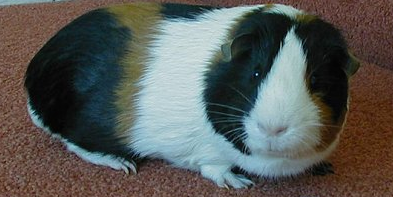Hyperthyroidism in Four Guinea Pigs: Clinical Manifestations, Diagnosis, and Treatment
by F. Künzel, B. Hierlmeier, M. Christian, and M. Reifinger
Only limited information regarding hyperthyroidism in guinea pigs has been reported, much of which has been published as a general review article (1-3). Therefore, veterinarians may not be aware of this disease, resulting in under-diagnosis of this condition.
The purpose of this case series by Künzel et al. (4) is to describe the results of diagnosis, treatment, and outcome of guinea pigs with hyperthyroidism. The goal was to provide additional information about this disease to help clinicians dealing with guinea pigs that may be suspected of having this disease.
Case Series of 4 Guinea Pigs Suffering from Hyperthyroidism
Signalment: Hyperthyroidism was diagnosed in four guinea pigs (3 females and 1 male), ranging in age from 3 to 6 years. These 4 cases represented 1.3% of guinea pigs examined at the University clinic during the same 2.5-year period.
Clinical features: Clinical signs reported in all guinea pigs included weight loss despite the maintenance of a normal appetite. Polyuria was noted in 2 of the 4 cases.
Physical examination findings: Physical examination revealed evidence for weight loss and a palpable mass in the ventral cervical region in all guinea pigs. Additional findings in individual guinea pigs included unkempt hair coat, tachycardia and tachypnea.
Serum chemistry results and thyroid hormone determinations: All 4 of the guinea pigs showed elevated serum alanine aminotransferase (ALT) activity. The diagnosis of hyperthyroidism was confirmed by demonstration of increased serum total thyroxine (T4) concentrations in all guinea pigs, as measured by chemiluminescent technique (5).
Treatment: Surgical thyroidectomy was attempted in 1 case but the guinea pig died during anesthetic induction. Histopathology confirmed thyroid adenoma.
The other 3 guinea pigs were treated with methimazole, using starting doses of 1-1.4 mg/kg/day. Based on clinical signs and results of follow-up serum T4 values, the final methimazole doses ranged from 2-3 mg/kg every 24 hours in 2 cases and 2.5 mg/kg every 8 hours in the third guinea pig. In this latter case, radioactive iodine treatment was eventually performed.
Response to treatment: All 3 of the treated guinea pigs showed progressive weight gain as serum T4 concentrations fell to within the reference interval. However, all died of unknown causes 18-28 months following initial treatment.
My Bottom Line:
Hyperthyroidism in guinea pigs represents a relatively new addition to the list of differential diagnoses for weight loss in guinea pigs (2-4). In many ways, the description and management of hyperthyroidism in these 4 guinea pigs mimics the situation we had with feline hyperthyroidism in the early 1980’s, as we were just starting to routinely recognize this common disease in cats (6,7).
The signalment (middle-aged to senior), clinical signs (weight loss despite a good appetite) and physical exam findings (palpable thyroid nodule) displayed by these guinea pigs are all remarkably similar to those of the typical hyperthyroid cat. The finding of a high total T4 concentration was diagnostic in all of these 4 guinea pigs, as it is in over 90% of hyperthyroid cats.
Treatment with methimazole was successful in management of 3 of the 4 guinea pigs. However, on a body weight basis, much higher daily doses were needed for the guinea pigs, at least compared to the typical hyperthyroid cat. Use of radioiodine therapy also appears to be a safe and promising treatment for guinea pigs suffering from hyperthyroidism (2,5). However, more work needs to be done before this becomes an accepted therapeutic approach for hyperthyroidism in the guinea pig.
References:
- Mayer J, Hunt K, Eshar D, et al. Thyroid scintigraphy in a guinea pig with suspected hyperthyroidism. Exotic DVM 2009;11:25-29.
- Mayer J, Wagner R, Taeymans O. Advanced diagnostic approaches and current management of thyroid pathologies in Guinea pigs. Vet Clin North Am Exot Anim Pract 2010;13:509-523.
- Brandao J, Vergneau-Grosset C, Mayer J. Hyperthyroidism and hyperparathyroidism in guinea pigs (Cavia porcellus). Vet Clin North Am Exot Anim Pract 2013;16:407-420.
- Kunzel F, Hierlmeier B, Christian M, et al. Hyperthyroidism in four guinea pigs: clinical manifestations, diagnosis, and treatment. J Small Anim Pract 2013; 54:667-671.
- Muller K, Muller E, Klein R, et al. Serum thyroxine concentrations in clinically healthy pet guinea pigs (Cavia porcellus). Vet Clin Pathol 2009;38:507-510.
- Peterson ME, Johnson JG, Andrews LK. Spontaneous hyperthyroidism in the cat. Spontaneous hyperthyroidism in the cat. Proceedings of the American College of Veterinary Internal Medicine 1979: 108.
- Peterson ME, Kintzer PP, Cavanagh PG, et al. Feline hyperthyroidism: pretreatment clinical and laboratory evaluation of 131 cases. J Am Vet Med Assoc 1983;183:103-110.


No comments:
Post a Comment